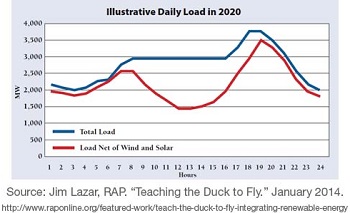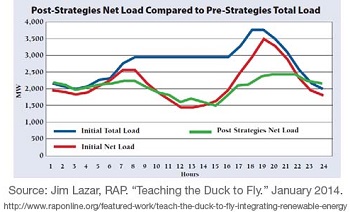As zero net energy (ZNE) and other low-energy buildings become increasingly common, we have to think about how different ZNE strategies can interact with their local electricity grids. The electricity grid was built as a one-way street, with energy flowing from the power plant to the consumer. Widely distributed renewable energy systems and other cutting-edge building technologies will change that equation.
Let’s consider three tiers of demand response and renewable energy technology integration in commercial buildings:
- Conventional buildings with one-way energy flows or conventional net metering
- Moderately responsive buildings with interactive demand response capacity
- Fully grid-integrated buildings with active and passive efficiency and demand response features, often with onsite renewable energy.
This third tier represents the buildings of the future. These buildings integrate grid-sensitive design features, fully dispatchable demand response across major end-uses, and carefully designed and installed renewable energy technologies that are intended to improve the relationship between the building and the electricity grid.
I like to think of the ZNE buildings of the future as being somewhere on a scale between two fundamental building typologies: renewable-oriented and efficiency-oriented. The way buildings of these two types interact with the grid is very different.
The load shape impacts of these buildings and their renewable energy systems can be very significant. Jim Lazar published a paper in January 2014 titled “Teaching the ‘Duck’ to Fly” in which he discusses the impacts of increasing renewable energy generation on California’s energy grid and outlines 10 strategies that can help prevent or address the potential problems these changes will pose. The first graph below shows the predicted load shape on an illustrative day in southern California in 2020. It represents a somewhat extreme case at this point in time and for the near future. However, if all the new ZNE buildings were renewable-oriented we might see something like the second graph below in the future.
However, if all the new ZNE buildings were renewable-oriented we might see something like the second graph below in the future.
The blue line shows the total load on the system. The red line, often called the “Duck Curve,” shows what could happen if the state achieves its Renewable Portfolio Standard (RPS) goals in 2020 without careful consideration of how to accommodate renewable energy’s impact on the load shape.
The grid impacts of efficiency-oriented ZNE buildings can be largely prevented by grid-sensitive design strategies and operational choices. The effects of these strategies and choices can flatten out the load shape significantly and can help reduce the peak demand issues illustrated in the first graph (the Sitting Duck).
The graph shows the predicted load shape on an illustrative day in California in 2020–just as the last graph–both before (red) and after (green) the adoption of Lazar’s 10 recommended strategies. In this case, the duck has taken flight (resulting in significantly lower peak demand and less dramatic ramping rates), with positive impacts for the utilities and society as a whole.
The buildings of the future, whether operating at a ZNE level or not, will need to be explicitly designed with both active and passive features and technologies to optimize interaction with the utility grid. Passive design strategies, such as building orientation, daylighting and passive space conditioning are foundational steps and should be implemented whenever practical. Active strategies such as night ventilation, thermal storage, or demand response will also be instrumental and, when necessary, can allow buildings to be used as storage for the grid. Renewable energy systems should be carefully chosen and designed to interact well with the grid. For example, wide adoption of east-west oriented solar PV systems could provide significant benefits to grid operators where the onsite generation load shape better matches the grid demand load shape.
NBI is thinking about how to establish a framework for employing design strategies and measures that ensure buildings of the future can benefit from, and support, grid modernization efforts. Jim Edelson, NBI’s Director of Codes and Policy, and I have written a paper about this topic and it was published by ASHRAE. I discussed these topics in a panel setting at the ASHRAE Winter Conference in Orlando, FL, on January 27, 2016.
These issues are important and feed into NBI’s thinking about technologies, strategies and policies to improve the buildings of the future and the utility grid. We would love to hear your feedback and your thoughts on this topic; please drop me a line at [email protected]
